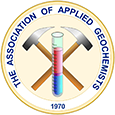AAG Distinguished Lecturer
Past Distinguished Lecturers
This page summarizes past AAG Distinguished Lecturers and content as a resource to the geochemistry community.
In some cases, links to lectures are provided. All documents are free for reading and sharing within applied geochemists, but they retain their author's copyright and should not be modified, or reused for commercial purposes, without the written permission of their author or of the AAG.
2015-16: Dr. Dan Layton-Matthews.
- An Applied Geochemist Convert
- Background and anomalous trace element compositions and isotopic ratios of all minerals within sedimentary and magmatic rocks related to ore systems, including the mineral, elemental and isotopic transfer to surficial media
2013-2014 : Dr. Ravi Anand
- Understanding anomaly formation through transported cover:field and experimental approaches.
- Regolith-landscape processes and evolution and their implications to mineral exploration
- Role of palaeoclimates, mineralogy and geochemistry in forming anomalies on interfaces in areas of deep basin cover-implications for exploration
- Origin of ferruginous pisoliths in terrestrial environments-success in mineral exploration and clues to life on Mars
- Exploration through transported cover - can we predict which sample medium works where and why?
2011-2012: Dr. Rob Bowell and Scott Long
Dr. Rob Bowell:
- Geochemical exploration for uranium; deconvolution, disequilibrium and details
- Occurrence of uranium in Africa and implications for finding new uranium deposits
- Role of mineralogy in interpreting applied geochemistry data
- The Role of Applied Geochemistry in the Mine-Life Cycle
- Predicting quality of water: use and abuse of geochemical predictive calculations in the prediction of mine water chemistry
- Close relationship between elephants, bat guano and zeolites
Scott Long:
- Customizing metallic (screen) fire gold assay procedures for coarse gold projects
- Assay techniques for estimating Ni sulphides and Ni in silicates in ultramafic Nickel deposits
- How to use duplicate results to guide improvements in precision of the sampling-preparation-assaying process
- Graphical presentation of Quality Control Data: how to communicate the essential and direct attention to areas in need of improvement
- Approaches to evaluating the integrity of assay databases when doing an audit of due diligence
2007-2009 : Dr. Kurt Kyser
- Controls on ore forming processes in sedimentary basins and their implications for exploration strategies
- Using isotopes as tracers of sources and processes for element migration: new frontiers that add value to exploration geochemistry
- Using new techniques in biogeochemistry to monitor the environment and find undercover ore deposits
2005-2006 : Stew Hamilton
- Reduced Chimneys and Electrochemical Transport over Oxidizable Geological Features.
- "Forest Rings" and Their Implications for Geochemical Exploration of Oil, Gas and Mineral Deposits.
- Geochemical Exploration in Areas of Thick Glacial Cover.
2003-2004 : Dr Cliff Stanley
- Lithogeochemistry: what you discover depends on where you stand
- Hydrothermal alteration zones at two massive sulphide deposits: contrast in lithogeochemical expression due to host rock controls
- Molar element ratio analysis of granitoid batholiths: insights into magmatic and assimilation processes that affect exploration strategies and tactics
2002 : Dr. Clemens Reimann
- The Kola Geochemistry Project: An environmental investigation in Arctic Europe
- Geochemical Provinces: Do they exist and what is their relation to regional geology?
Dr. Clemens Reimann was AAG's Distinguished Lecturer in 2002. Since then, he has contributed extensively to the development of geochemical atlases at the European level, especially with the GEMAS project (http://gemas.geolba.ac.at/).
His presentation of the GEMAS approach is available here <15Mb PDF file>.
More information is available on the GEMAS web site and from Clemens's scientific papers.
